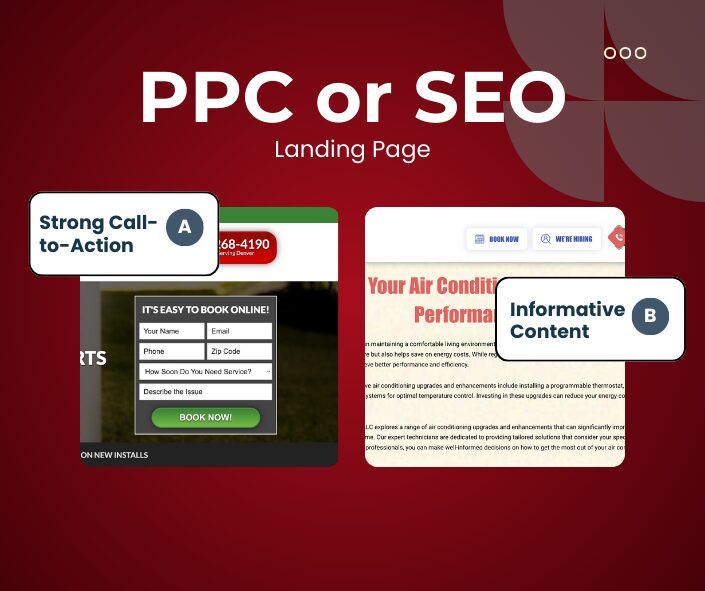How To Create And Optimize SEO Content
A No-Nonsense SEO Writing Playbook for Ranking Your Website Above Your Competition
Here at CI Web Group, we’re well versed in all things hvac digital marketing. One of the most important digital marketing pillars for organic visibility is none other than Search Engine Optimization. And when it comes to optimizing your SEO, a crucial component is content writing. You simply can’t have one without the other. With over 12 years’ worth of experience of producing tangible results, in the trenches industry knowledge, and has now helped over 1,700 clients reach their business goals, we’re going to lay it all out for you, step-by-step in plain English.
Data-driven content creation is guaranteed to help you skyrocket the visibility of the most important pages on your website. Higher visibility means better rankings, which in turn means more eyeballs to your offers. But how do you go about the whole process? Good writing skills are essential, but it’s only one piece of the puzzle. Making the article interesting enough and easily readable is another critical element. Going beyond just that, you need to make sure to strategically place keywords, include hyperlinks and metadata, titles, as well as other media with the necessary tags for an added boost. You can fire up your search engine rankings with several different techniques. In fact, here’s a quick and complete overview of the most important factors that go into your SEO performance:
- Getting a higher score in terms of content quality (i.e. better content with all the necessary keywords)
- Increasing your website’s authority (i.e. better links from other reputable websites)
- Increasing the trust in the eyes of the beholder, in which case, Google and other search engines. This is done by taking into account domain factors, site-level factors, page-level factors, user interaction, special google algorithm rules, brand signals, on and off-site webspam factors and more.
For each and every one of those areas, your average score is factored in the algorithm in order to figure out where you rank in comparison to all the other players in the market. This means that optimizing your website with search results in mind revolves around getting the best possible scores across the board. From keyword research, titles, URLs, meta descriptions, ALT tags, all the way to actual content writing, below you will find a step-by-step process that can and will ensure results.
Step 1: Keyword Research
Learning how to come up with money-making keywords is the first step in the process. Keyword research is the practice of finding and using keywords of interest, in other words phrases people search on search engines that directly relate to your business. There are many types of keywords out there, with the most important being location based and industry based. These can either be single words or phrases containing 3-5 words at a time. The latter are called long-tail keywords (3 words or more), and it’s a smart move to focus on these since they are less competitive and offer a great support backbone to your main keywords. They have a lower search volume, but still present an awesome opportunity to rank higher on SERPs (search engine result pages).
Combining both short and long-tail keywords is the ultimate goal in this first step. In order to do this effectively, you need the help of one or more keyword research tools. These will make your life much easier when you want to carry out keyword research for your SEO-friendly service pages or blogs:
In addition to finding the keywords of interest for your business, you can also:
- Search on google about a topic, and you’ll see related keywords popping up on your screen right underneath the search bar
- Research your industry, and specific niche-related subjects on Quora
- Spy on your competition to see which keywords are working for them
- Search for LSI (Latent Semantic Keywords) with LSI Graph
The easiest way to see what keywords are being used by your competition is to use SEMRush. It’s always a good idea so you can get a feel for what keywords are already working, as well as how your work will stack up against your competition. Another option to go about this is to simply perform a quick Google search. Use the keyphrases you want to optimize for, turn to the results and make a mental note of their position on the SERPs. If they’ve got little content with low authority on that page, you can bet you will rank with a bit more extensive work (say 300 words more of optimized content) on the article you’ll write to target the same keywords (provided that your competition won’t keep on adding to their respective pages). A final thing to keep in mind on this topic is keyword frequency and density. It’s not a great idea to stuff your content with the keywords you just found. This technique used to work in the past but it has long fallen in the spam and blackhat bucket. You should try and incorporate your keywords in a natural way, while creating a high quality piece of content that’s valuable to your readers. Google’s algorithms are smarter than you think!
Step 2: SEO-Optimized Titles
Your titles are an integral part of every piece of content that you will create. Not only do they help divide the text into readable chunks, but they also help the reader skim through and get an idea of what it is that you’re talking about much faster. When it comes to SEO though, SEO optimized titles that include your keywords take a whole lot more weight. They are vital if you want to rank high and they are by far one of the most important factors of the equation.
Your title allows search engine crawlers (which are defined as signals sent by search engines to scan your website) to easily understand the context of your page and place it in the appropriate bucket of data. You should also pay attention to the length of your title, since search engines tend to have a limit. Here is a very handy tool that will make sure you won’t get cut off. Use it to predict how your web page will look like on SERPs after you make it live.
Having clear, straightforward titles that show intent and include power words is a great strategy. If you want some help with title generation use these tools:
When all is said and done, use CoSchedule to analyze your overall score. Consider including a couple of modifiers such as “free”, “how to”, “2020”, or “best”. The title will have to be set as an H1 tag on the respective page.
Your text should also feature several subheadings or H2 tags. It adds SEO Company in Houston, TX benefits and makes the text easier to read. It’s a great place to incorporate your LSI keywords but doesn’t go overboard. Try to not use the same information twice since search engines can and will be misled by such a move. Contrary to H1 tags that should only be used once per page, you can have as many H2, H3 and H4 tags (i.e. subheadings) as long as it makes sense.
Step 3: SEO-Friendly URL
A URL (Uniform Resource Locator) is another fancy word for a “website address”. It basically tells the system where to look for your specific query by giving the location of a source on the worldwide web. Another component of a URL is the protocol it uses such as HTTP, HTTPS, etc. It was designed to replace IP addresses (initially composed of numbers) for inter-server communication, and give it a human-readable character.
If you really want to nail down your SEO content, you have to start from the top. URLs are one of the first things that algorithms look at the moment they’re starting to crawl your webpage. They improve user experience, rankings, and link-building.
Avoid long URLs and URLs full of numbers (like this one https://www.domain.com/75131&
$12=729 ). Instead, focus on SEO-optimized URLs that include your key phrases in a dashed format such as https://www.domain.com/your-keyphrase-here. At this point, we can also note that a website URL’s first 2-4 words hold significantly more weight for the search engines, so make sure you put your keywords right after your domain name. Here’s a URL checker tool in case you need to check how SEO-friendly your URL is.
Step 4: Meta Descriptions
A meta description (or MD) refers to the short snippet of text right below the active link of an item on the SERPs. It’s the line of text right underneath the title (blue) and it’s generally used by Google as a synopsis of a given webpage. Having optimized meta descriptions is a powerful way to improve your SEO content writing. They simply play too big a role in your overall results.
If this is not optimized the algorithm jumps right in and takes whatever text comes after your title.
It’s imperative that your MD is appealing, concise and it must also include your main keyword for added SEO benefit. Make sure to use action-oriented language in order to persuade the reader to visit your site.
Most search engines tend to truncate snippets to approximately 155–160 characters. Keep this part of your SEO content long enough so that’s adequately descriptive, but bear in mind that your primary mission here is to provide value and drive clicks.
Step 5: Writing SEO Content, The Right Way
Content is KING. At the end of the day, all of the steps we outlined above would go in vain if your content is of subpar quality. Text that’s tainted with technical jargon, incorrect language, subpar readability, wrong keywords, and titles would immediately render the body of your text unfriendly for SEO. Following proper SEO content writing, principles is key if you really want to see your SEO efforts to fruition.
If you want to stand a good chance at ranking higher than your competitors you have to dedicate a lot of time to make sure that whatever it is that you write deserves to be read. This means that you have to create valuable, well-researched content that answers their questions and provides solid solutions. The piece of content that you will post on your website must be enjoyed by your target audience, in other words users that want more reliable info on the topic that you’re presenting.
Start off with a quick outline of your article. You really don’t have to reinvent the wheel. Come up with sources so you can pull ideas and integrate them on your article. Think of a good hook for your introduction and make it so that people want to keep on reading. You can opt for an entertaining or informative tone, or both. The common denominator is value.
You should already have your list of keyphrases ready to go from Step 1. These should be present across titles, meta descriptions, body text, and URL. Some people like to bold their main keyword. Google spiders will pick these up when you hit the publish button. Grammar and spelling mistakes should always be avoided and you also need to make sure to sprinkle your content with both internal and external links.
As a general rule of thumb, you should always avoid writing content that has fewer than 300 words. Generally speaking, the longer the better, and the more chances you would have for ranking well. You shouldn’t simply attempt to scratch the surface, but provide complete information on a given subject. Your SEO content has to be well-written and it must also include the keyword in the first sentence or paragraph. Subsequent keyword density is something that will be decided with total post length in mind. As we already explained, you need to stay clear of keyword stuffing. Have your main keyword incorporated 3 times every 500 words, and the secondary keywords once. The piece of content has to flow naturally and it must also be optimized for mobile since Google has started penalizing web properties without a preset mobile view.
Once you hit publish, make sure to build links to your article by asking other sites to post about it. Another great way is to have sharing buttons for social media that would help users share your content easily with their friends.
Conclusion
Search engine optimization is a continuous, never-ending process. If you start lagging behind your competitors will outrank you in a matter of months. As you’ve seen by now, SEO content writing is crucial, but going beyond simply writing the content there are some more technical elements that should normally be present. A fully mobile optimized website, media and image ALT tags, Google Search Console familiarity, Accelerated Mobile Pages (AMP) and more are some of the elements that would complement your SEO content writing in a nice way and would guarantee ranking complete and indisputable ranking domination. If you want to learn more, get in touch with one of our strategists today.
At Ciweb Group Inc, We offer professional SEO services affordable. Our main motive only is customer satisfaction.






















